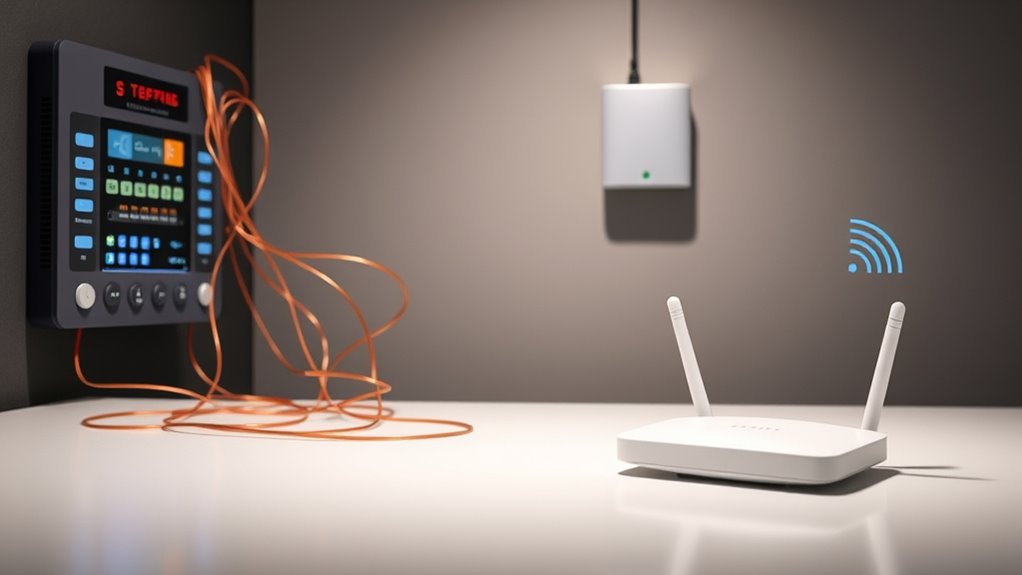Wired alarm systems rely on physical cables, offering higher reliability and security, but they require extensive installation and structural modifications. Wireless systems use radio signals for easier setup and device flexibility, but they may face interference and security concerns. Understanding the differences in components, signal types, security features, and installation needs helps you choose the best system for your space. Exploring these technical details will give you a clearer picture of what suits your security needs.
Key Takeaways
- Wired alarm systems offer high reliability with direct physical connections, while wireless systems provide flexible installation and easier scalability.
- Wireless systems are vulnerable to radio frequency interference and hacking, but often include encryption and adaptive protocols for security.
- Wired systems require extensive cabling and structural modifications, whereas wireless setups are simpler to install with minimal disruption.
- Wired alarms are ideal for large or critical environments due to their stability, while wireless systems suit remote monitoring and quick deployment.
- Both systems must consider aesthetic impact, compliance, and maintenance needs, with wireless often being less invasive and more adaptable.
Core Components and Architecture
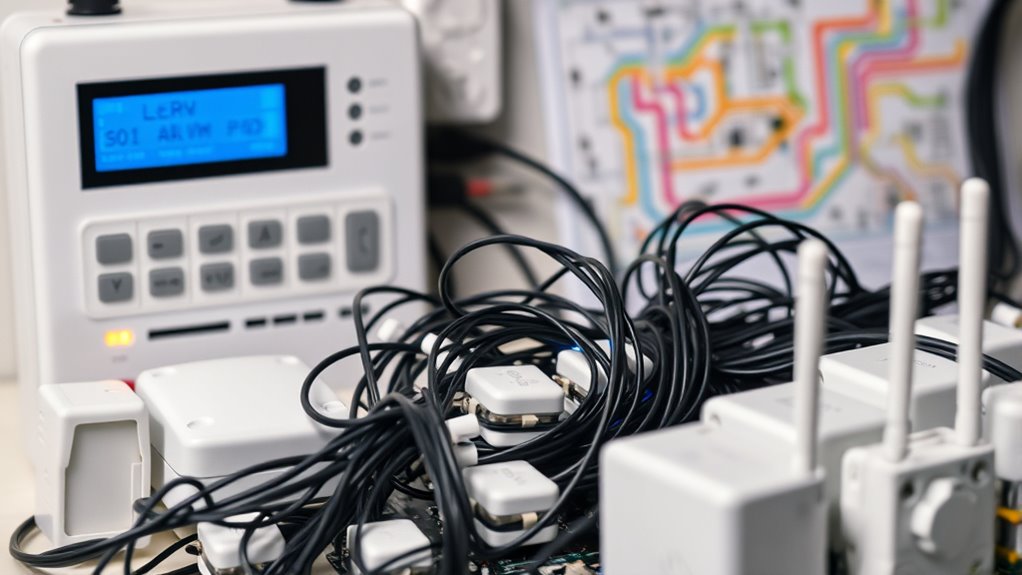
Understanding the core components and architecture of alarm systems is essential to choosing the right setup for your home or business. At the heart are sensors, which detect movement, entry, or environmental changes, and require regular sensor calibration to maintain accuracy. The user interface is your primary control point, allowing you to arm or disarm the system and customize settings easily. Wired systems typically connect sensors directly to a central control panel through physical cables, offering reliability. Wireless systems rely on radio signals, making installation simpler and more flexible. Both architectures depend on a robust core structure to ensure seamless operation. By understanding how sensors, user interfaces, and communication pathways work together, you can select an alarm system that best fits your security needs. Additionally, selecting the appropriate technology—such as high-quality sensors—can significantly impact the system’s overall effectiveness and reliability.
Communication Protocols and Signal Transmission
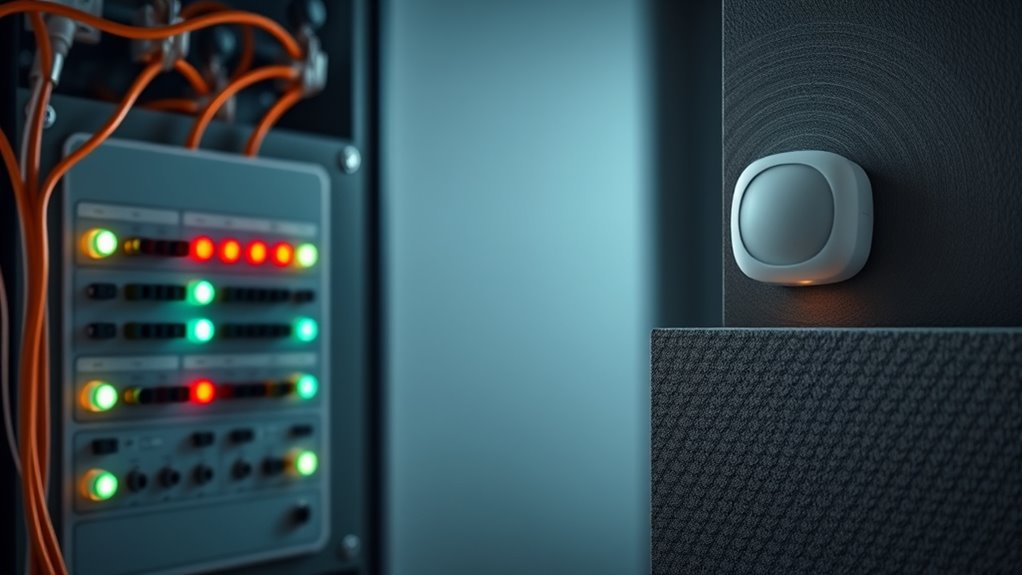
Understanding how signals are transmitted is key when choosing an alarm system. You’ll want to think about the types of signals and frequencies used, as well as how secure the data is through encryption. Interference can also affect reliability, so knowing how each system handles signal stability is vital. Additionally, some systems incorporate holistic health principles to optimize performance and resilience of the signal transmission.
Signal Types and Frequencies
Signal types and frequencies are the backbone of how wired and wireless alarm systems communicate. Wired systems typically transmit signals through physical cables, offering consistent, interference-free communication. In contrast, wireless systems rely on radio frequency signals, which use different signal modulation techniques to encode data. You’ll find that many wireless alarms utilize frequency hopping—rapidly switching among multiple frequencies—to minimize interference and improve reliability. This method guarantees your system stays connected even in crowded radio environments. Understanding these signal types and frequencies helps you gauge system robustness, with wired setups generally providing more stable signals and wireless options offering flexibility and ease of installation. Recognizing how signal modulation and frequency hopping work can guide you toward the best alarm system for your needs.
Encryption and Data Security
Encryption and data security play an essential role in protecting your alarm system’s communication from unauthorized access. Strong encryption algorithms ensure that signals between sensors and control panels remain confidential. To maintain data integrity, these protocols verify that information isn’t altered during transmission. Here are four key points:
- Modern encryption algorithms like AES encrypt data, making it unreadable to intruders.
- Secure communication protocols prevent interception and tampering.
- Frequent key updates enhance security, reducing vulnerability.
- Authentication processes verify device identities, preventing unauthorized access.
- Implementing cybersecurity consulting services can further strengthen your system against emerging threats.
Interference and Reliability
Interference can considerably impact the reliability of your alarm system’s communication, causing false alarms or missed alerts. Frequency interference from nearby devices, such as Wi-Fi routers or cordless phones, can disrupt signal transmission, reducing signal dependability. Wireless systems operate on specific frequencies, making them susceptible to external signals that interfere with communication. This interference can result in delayed alerts or missed events, compromising your security. To minimize issues, choose alarm systems with robust communication protocols that automatically switch frequencies or use frequency-hopping spread spectrum technology. Regularly inspect and update your system’s firmware to ensure peak performance. Additionally, understanding how Honda Tuning technologies optimize engine performance can offer insights into managing electronic systems effectively. Understanding how frequency interference affects your system helps you select reliable alarms and maintain consistent security coverage.
Installation Processes and Infrastructure Requirements
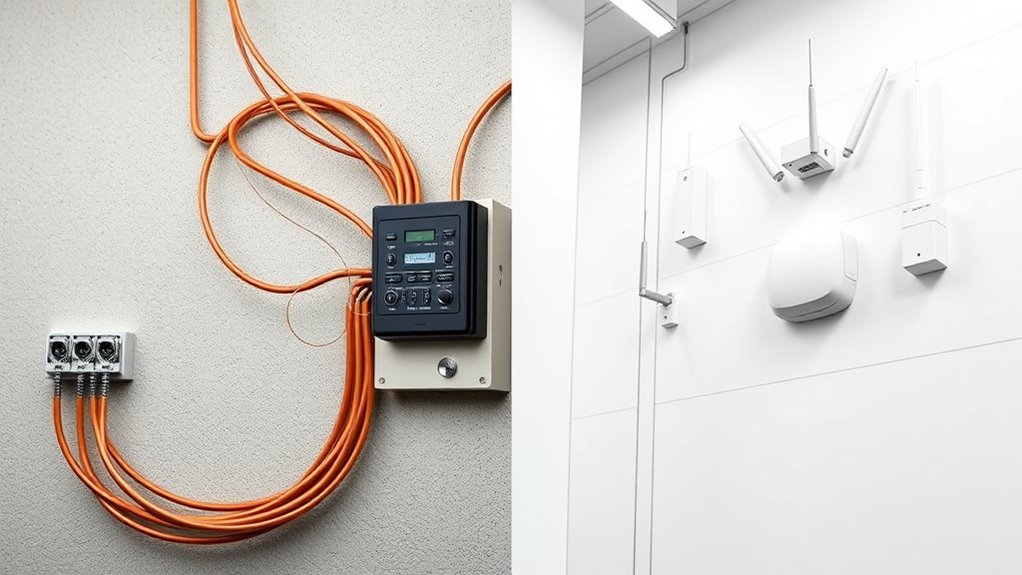
When installing alarm systems, you’ll notice that wiring complexity varies between wired and wireless options. Wired systems often require more extensive power sources and may need structural modifications, while wireless setups usually have simpler installation processes. Understanding these infrastructure needs helps you choose the best system for your home’s layout and existing setup. Additionally, considering the legal information such as terms and conditions can ensure compliance during installation.
Wiring Complexity Levels
Wiring complexity varies considerably between wired and wireless alarm systems, impacting installation processes and infrastructure needs. Wired systems require extensive cabling, which can be challenging to install and maintain, especially in existing structures. Wireless systems, however, minimize wiring concerns but can face issues like wireless interference that affect reliability. When contemplating wiring durability, wired setups generally offer long-term stability but demand more upfront work. Here are key points to consider:
- Wired systems need careful planning for cable routing to avoid damage.
- Wireless setups reduce physical wiring but depend on strong signals.
- Wireless interference can disrupt alarm functioning, requiring strategic placement.
- Wired wiring is more durable over time, less prone to signal loss or interference.
- Considering the Bedroom environment helps optimize the placement and reliability of alarm systems.
Understanding these factors helps you choose the right system based on infrastructure and reliability needs.
Power Source Needs
Wired alarm systems typically require a dedicated power supply and extensive cabling to connect sensors and control panels, which can complicate installation, especially in existing structures. Because of this, you need to guarantee a consistent power source, often relying on the building’s electrical system. Battery life isn’t a concern with wired systems since they don’t depend on batteries for operation. However, a reliable power backup is essential; if the main power fails, the system should switch seamlessly to backup power to maintain security. Without proper power backup, your alarm system could become inactive during outages. This infrastructure requirement makes wired systems more complex to install but provides continuous power, reducing the risk of false alarms caused by power interruptions. Additionally, installation complexity can increase overall costs and time needed for setup.
Structural Modifications Required
Installing wired alarm systems often requires significant structural modifications, especially in existing buildings. You may need to drill walls, run cables through ceilings, or create access points, which can disrupt aesthetics. Before proceeding, obtaining building permits is essential to guarantee compliance with local codes. To minimize visual impact, plan for aesthetic integration by hiding wiring or using conduit. Here are four key modifications:
- Drilling holes for cable routing.
- Installing conduit or raceways for neat wiring.
- Reinforcing walls or ceilings if necessary.
- Securing wiring to blend with interior design.
Additionally, conducting a thorough site assessment can help identify potential challenges and streamline the installation process. These steps ensure a professional, compliant installation, but they also mean more planning and potential disruptions. Structural modifications are often unavoidable, making wired systems more invasive than wireless alternatives.
Security Features and Vulnerabilities
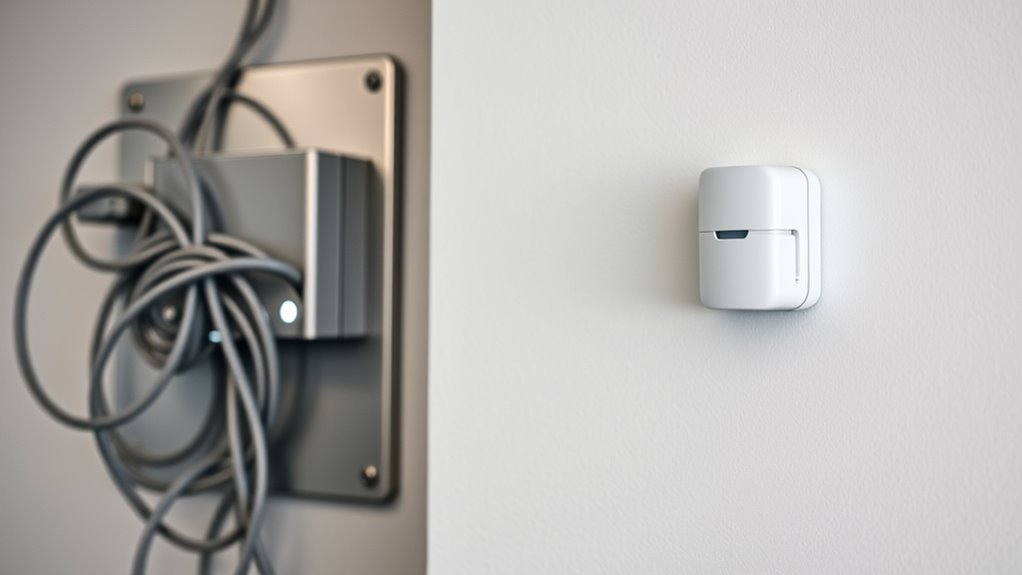
While both wired and wireless alarm systems aim to protect your property, their security features and vulnerabilities differ considerably. Wired systems are less vulnerable to hacking but can be physically tampered with, while wireless systems rely on radio signals that can be intercepted or jammed. Remote monitoring enhances security in wireless setups, allowing you to check your system remotely. The user interface also plays a vital role, with wireless systems often offering more user-friendly controls. However, wireless systems may face vulnerabilities like signal interference or hacking attempts. Wired systems are more resistant but less flexible. Here’s a quick comparison:
| Feature | Vulnerability |
|---|---|
| Wireless communication | Signal jamming, hacking |
| Wired connections | Physical tampering |
| Remote monitoring | Unauthorized access if weak security |
Additionally, security features such as encryption can significantly reduce the risk of hacking in wireless systems.
Maintenance, Scalability, and Flexibility
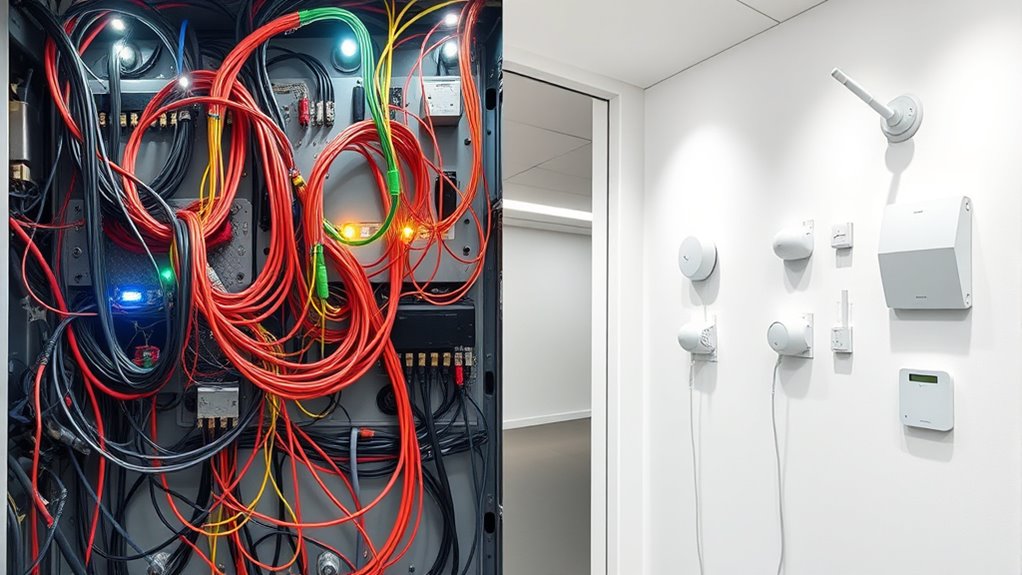
Maintenance, scalability, and flexibility are key factors to contemplate when choosing an alarm system, as they directly impact your ability to adapt and manage your security setup over time. Wireless systems often excel here by offering easier remote monitoring and quick device integration, making upgrades simpler. Wired systems, however, can require more effort for maintenance due to physical connections. Consider these points:
- Remote monitoring capabilities simplify ongoing maintenance and system checks.
- Wireless setups allow easy addition or removal of devices for scalability.
- Wired systems may need more extensive work for device integration when expanding.
- Flexibility in system configuration is higher with wireless, accommodating future technology updates.
Your choice should align with your need for adaptable, manageable security that can grow with your property.
Typical Use Cases and Performance Considerations

Choosing between wired and wireless alarm systems depends heavily on your specific use case and performance expectations. Wireless systems excel in remote monitoring and quick deployment, making them ideal for rentals or temporary setups. Wired systems often provide more reliable connectivity, better suited for environments where consistent performance is critical. Your user interface design also influences your choice; intuitive controls enhance user experience regardless of system type. Consider the table below for quick comparison:
| Use Case | Performance Considerations |
|---|---|
| Large commercial spaces | Wired systems offer stability and security. |
| Remote monitoring needs | Wireless systems provide flexibility. |
| DIY installations | Wireless systems are easier to install. |
| User interface preferences | Wireless may have advanced, user-friendly apps. |
| Critical security environments | Wired systems minimize interference risks. |
Frequently Asked Questions
How Do Wired and Wireless Systems Compare in Power Consumption?
When comparing wired and wireless alarm systems, power efficiency and energy usage are key factors. Wired systems typically consume less power because they rely on existing electrical wiring, making them more energy-efficient over time. Wireless systems, on the other hand, require batteries or power adapters for sensors and control panels, which can lead to higher energy usage. Your choice depends on balancing lower power consumption with installation convenience and flexibility.
What Are the Environmental Impacts of Each System Type?
Think of environmental impacts like a garden that needs careful tending. Wired systems, with their heavy cables and metal components, pose recycling challenges due to complex materials, impacting sustainability. Wireless systems, relying on batteries and plastics, create waste from battery disposal and non-biodegradable parts. Both contribute to environmental strain, but wireless systems often have a lighter footprint if managed properly, emphasizing the importance of material sustainability and responsible recycling.
Can Wireless Alarms Operate During a Power Outage?
Wireless alarms can operate during a power outage if they have backup power sources like batteries. This guarantees your system remains active even when the main power’s out, maintaining signal reliability. You should check if your wireless alarm system includes a battery backup, so you’re confident your security stays intact during blackouts. Without backup power, wireless alarms won’t function, leaving your property vulnerable.
What Is the Typical Lifespan of Wired Versus Wireless Components?
Did you know that wired components often last over 10 years, while wireless parts typically need replacing every 3 to 5 years? You can expect wired components to have greater durability, reducing upgrade frequency and long-term costs. Wireless systems, though easier to install, usually have shorter lifespans due to battery dependency and technology updates. So, if longevity matters, wired options generally offer better component durability.
How Do Installation Costs Differ Between Wired and Wireless Alarms?
When comparing installation costs, you’ll find wireless alarm systems often cost less upfront because of easier installation, thanks to less wiring and simpler setup. Wired systems tend to have higher installation costs due to their complexity, requiring more labor and time. Additionally, wireless components are generally less durable and may need replacement sooner, which can add to long-term costs. So, consider installation complexity and component durability when choosing what’s best for your needs.
Conclusion
Choosing between wired and wireless alarm systems is like picking the right tool for a job—you need the one that fits your needs best. Wired systems offer reliability like a steadfast anchor, while wireless options bring flexibility and ease of installation. Consider your space, security needs, and future plans. Ultimately, both can protect your home, but understanding their differences helps you make a choice that’s as clear as day and as solid as steel.
